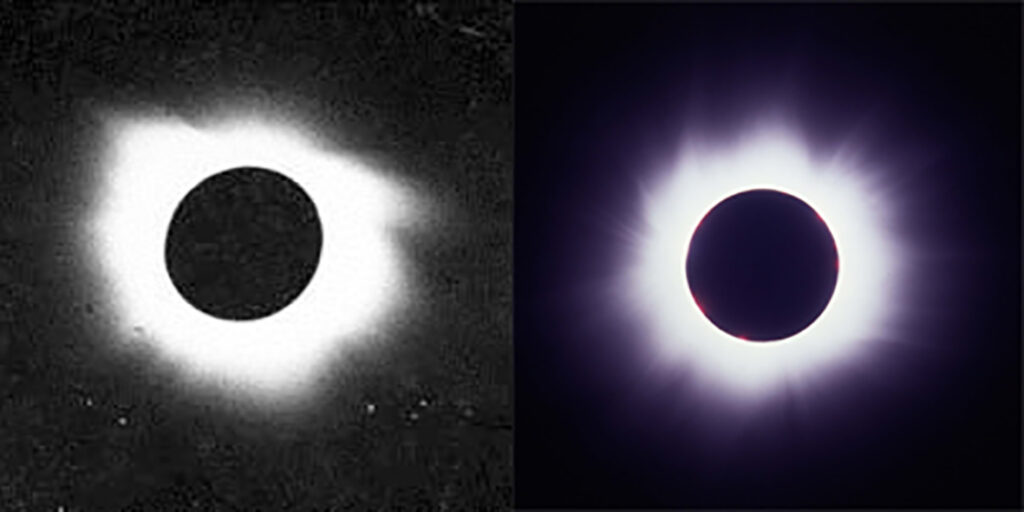In 1899, five years after establishing the first Bulgarian astronomical observatory in Sofia,Marin Bachevarov started regular sunspot observations with his students with the foremost telescope in Bulgaria – a 6-inch refractor [1] .
In the mid-XXth century Angel Bonov lays the foundation of solar physics in Bulgaria with hisstudies on the 22- [2] , 44- [3] and 176-year [4] cycles of solar activity and the first heliophysics course, led in Sofia University. Other scientist, like Marin Kalinkov and Donka Raikova, also give their contribution in solar research in the newly established Astronomical Department in the Institute of Physics of Bulgarian Academy of Sciences in 1952. In 1977 Vladimir Dermendzhiev becomes the first to get a PhD in heliophysics in Bulgaria after defending a thesis “Study on the height, heliographic distribution and activity cycles of solar prominences”. In 1985 he established Solar Physics Department and marks the beginning of regular and extensive research on Sun and solar activity in our country.
In the early 1990s, a solar tower with 8-m Carl Zeiss dome, built in the National Astronomical Observatory (NAO) Rozhen, marks the first steps of observational heliophysics in Bulgaria. It was equipped with 13-cm refractor to explore solar photosphere (left panel on the image below). The initiator and head of the project was Vladimir Dermendzhiev. After almost 15 years of usage, in 2005 the 13-cm telescope in the solar tower of NAO is replaced by 15-cm coronagraph (right panel on the image below). Supplied with Hα filter, its main purpose is dedicated to observations of solar prominences.

Meanwhile, for less than 40 years the path of lunar shadow passes through Bulgarian lands twice – in 1961 and in 1999, and solar physicist use the opportunity to organize total solar eclipse observations. On 15 February 1961 despite the unfavourable weather conditions Marin Kalinkov makes one of the first successful attempts in Europe to observe the eclipse aboard plane in order to extend the totality (left panel on the image below) [5] . The expedition, held 38 years later (on 11 August 1999) in northwestern part of the country included more participants and scientific experiments under the supervision of National Council for Coordination of Observational Programmes (headed by D. Mishev) [6] . The observations were successful covering topics from spectral and white-light observations of the corona (right panel on the image below) to geomagnetic and seismological research.This two events establish the Bulgarian total solar eclipse observations. In the years after it outgrows in organization of Bulgarian solar eclipse observational expeditions abroad with the eclipses in 2006 [7] , 2009 [8] , 2017 [9] and 2019 [10] .

In 2019 a project for construction of new solar telescope in NAO Rozhen started. It is currently in its final phase and the telescope is expected to receive its first light in 2022.
Sources:
[1] N. Petrov, D. Kjurkchieva, Ts. Tsvetkov (2018) Astronomical and Astrophysical Transactions 30 (4) 441-452.
[2] A.D. Bonov (1975) On the Relation between the 11-Year Cycles Which Constitute the 22-Year- Cycle of Solar Activity. Astrophysical Investigations 1 5.
[3] A.D. Bonov (1977) On the 44-year cycle of solar activity. Byulletin Solnechnye Dannye Akademie Nauk SSSR 1977 66-70.
[4] A.D. Bonov (1973) Characteristic Features of Secular and Supersecular Cycles of Solar Activity. A 180-Year Cycle. In: Solar Activity and Related Interplanetary and Terrestrial Phenomena. Proceedings of First European Astronomical Meeting, Athens, Greece, 4-9September 1972.
[5] V.N. Dermendzhiev, D. Mishev, K. Koleva (1999) “Solar eclipses”. Prof. Marin Drinov Academic Publishing House
[6] V.N. Dermendjiev, D. Mishev (1999) Final Status of Preparation of the Observational Programme for 1999 Total Solar Eclipse in Bulgaria. In: Third Advances in Solar Physics Euroconference: Magnetic Fields and Oscillations, ASP Conference Series 184 344-347.
[7] J. Kokotanekova, N. Petrov, P. Duchlev (2007) Observations of the total solar eclipse on22 July 2009 in China. Bulg. J. Phys. vol. 34 s2 224-231.
[8] N. Petrov, P. Duchlev, K. Koleva (2010) Observations of the total solar eclipse on 22 July2009 in China. Bulgarian Astronomical Journal 14 102.
[9] Ts. Tsvetkov (2020) Bulgarian Astronomical Journal 33 117.
[10] Ts. Tsvetkov, N. Petrov, R. Miteva, E. Ivanov, V. Popov (2019) Research on Active Solar Processes During 2019 July 2 Total Solar Eclipse. Proc. of the Eleventh Workshop“Solar Influences on the Magnetosphere, Ionosphere and Atmosphere”, Primorsko, Bulgaria,3-7 June 2019.
More information:
– Ts. Tsvetkov, N. Petrov (2021) Development of Solar Observations in Bulgaria: New30-cm Chromospheric Telescope. Bulg. J. Phys. vol. 47 55-61.
– Ts. Tsvetkov, N. Petrov (2020) New 30-cm Solar Telescope at National Astronomical Observatory Rozhen. Proc. of the Twelfth Workshop “Solar Influences on the Magnetosphere, Ionosphere and Atmosphere”, September, 2020.

